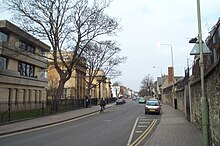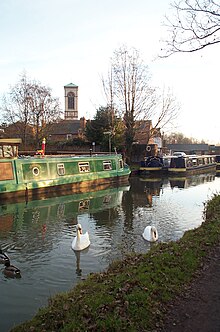Jericho, Oxford: Difference between revisions
m Sp |
No edit summary |
||
| Line 2: | Line 2: | ||
[[Image:WaltonStreetJerichoOxford lookingNorth20060314 KaihsuTai.jpg|thumb|right|Jericho, looking north down [[Walton Street]] from the southeast corner of the neighbourhood. [[Oxford University Press]] is on the left hand side.]] |
[[Image:WaltonStreetJerichoOxford lookingNorth20060314 KaihsuTai.jpg|thumb|right|Jericho, looking north down [[Walton Street]] from the southeast corner of the neighbourhood. [[Oxford University Press]] is on the left hand side.]] |
||
'''Jericho''' is |
'''Jericho''' is a historic suburb of the [[England|English]] city of [[Oxford]]. Located just outside the old [[city wall]], it was originally a place for travellers to rest if they had reached the city after the gates had closed. The area was originally an industrial area which grew up because of the presence of the [[Oxford Canal]], which arrived in 1790. Ironworks, wharves and the [[Oxford University Press]] were based there and its residential streets are mostly 'two-up, two-down' [[Victorian era|Victorian]] workers' houses. With backstreets of nineteenth century [[terraced housing]] and many restaurants, it has become a hugely popular location for [[student]] and [[London]] commuter accommodation. |
||
In the [[1950s]], Jericho was briefly a [[prostitution|red light]] area, and in the early 1960s there were plans to demolish it and replace it with light industrial units and new housing. However, many people objected and campaigned to save this historic area, rallied by local city councillor Olive Gibbs and the Jericho Residents Association. As a result the plans were changed. Although the houses beyond repair were demolished many were upgraded in the late 1960s and early 1970s with the help of council grants. This encouraged many young professionals and families to move in and subsequently Jericho became one of Oxford's most sought-after areas. Jericho is believed to be named after the local pub, the Jericho Tavern. The area, especially along [[Walton Street]], is very fashionable among diners, pub enthusiasts and cinema goers. |
In the [[1950s]], Jericho was briefly a [[prostitution|red light]] area, and in the early 1960s there were plans to demolish it and replace it with light industrial units and new housing. However, many people objected and campaigned to save this historic area, rallied by local city councillor Olive Gibbs and the Jericho Residents Association. As a result the plans were changed. Although the houses beyond repair were demolished many were upgraded in the late 1960s and early 1970s with the help of council grants. This encouraged many young professionals and families to move in and subsequently Jericho became one of Oxford's most sought-after areas. Jericho is believed to be named after the local pub, the Jericho Tavern. The area, especially along [[Walton Street]], is very fashionable among diners, pub enthusiasts and cinema goers. |
||
Revision as of 15:39, 13 January 2008
51°45′34″N 1°16′04″W / 51.7595°N 1.267676°W

Jericho is a historic suburb of the English city of Oxford. Located just outside the old city wall, it was originally a place for travellers to rest if they had reached the city after the gates had closed. The area was originally an industrial area which grew up because of the presence of the Oxford Canal, which arrived in 1790. Ironworks, wharves and the Oxford University Press were based there and its residential streets are mostly 'two-up, two-down' Victorian workers' houses. With backstreets of nineteenth century terraced housing and many restaurants, it has become a hugely popular location for student and London commuter accommodation.
In the 1950s, Jericho was briefly a red light area, and in the early 1960s there were plans to demolish it and replace it with light industrial units and new housing. However, many people objected and campaigned to save this historic area, rallied by local city councillor Olive Gibbs and the Jericho Residents Association. As a result the plans were changed. Although the houses beyond repair were demolished many were upgraded in the late 1960s and early 1970s with the help of council grants. This encouraged many young professionals and families to move in and subsequently Jericho became one of Oxford's most sought-after areas. Jericho is believed to be named after the local pub, the Jericho Tavern. The area, especially along Walton Street, is very fashionable among diners, pub enthusiasts and cinema goers.
The cinema has had a number of incarnations. It started in from 1913 as the North Oxford Kinema. In the 1925 it was renamed the Scala, then in 1970 it was split in two and became Studios 1 and 2, one of which showed soft-porn. In 1977 the cinema revived again after being taken over by the London company Contemporary Entertainments and acquired its current name, the Phoenix, showing first-run films.
Among some of the more recognizable places to relax are The Jericho Cafe and 'Jude The Obscure', a public house highly popular with local residents. [citation needed]

With its gentle biblical name, Jericho is also known for its iconic places of worship. The Anglo-Catholic St Barnabas Church [1] is the Church of England parish church in Jericho, next to the Oxford Canal. The Albert Street Chapel [2] (Reformed Baptist) is also in the neighbourhood.
Jericho continues to have a strong community spirit. The Jericho Community Association runs the Jericho Community Centre[3] in Canal Street, publishes the local newspaper the Jericho Echo[4] and organizes the annual Street Fair which is held in mid-June each year, around the feast day of the patron saint Barnabas (11 June). It is also the focus for other community activities and has also been very active in campaigning for responsible development of the canalside land behind St. Barnabas Church on a small part of which it plans to build a new Community Centre.
The Oxford Synagogue (one of the few in England with more than one denomination of Judaism worshipping in the same house) and the Oxford Jewish Centre [5] are located in Jericho. St. Sepulchre's cemetery on Great Clarendon Street.
The headquarters of the Oxford University Press occupy a large area bounded by Walton Street and Great Clarendon Street.

Castlemill Boatyard is a 160-year-old wharf on the canal in Jericho, owned by British Waterways and now closed. There are controversial plans to sell the site. Since the yard's closure of the yard, Jericho Community Boatyard Ltd has been set up to restore services for Oxford Boaters and protect the future of Castlemill Boatyard [citation needed].
At the northern end of Jericho for many years, also by the canal, was Lucy's Eagle Ironworks, also now closed and awaiting redevelopment.
Jericho in literature
The first episode of the long running ITV drama series Inspector Morse, starring British actor John Thaw called "The Dead of Jericho", was partially filmed in the streets of Jericho, notably Combe Road (which is 'Canal Reach' in the drama). It also featured the exterior of the 'Bookbinders Arms' pub on the corner of Victor Street.
Philip Pullman set parts of his novels Northern Lights and Lyra's Oxford in Jericho. In the books, Jericho is home to the water-dwelling "Gyptians". He has been a vocal advocate of the residential boaters' fight to save the Castlemill Boatyard [6].
